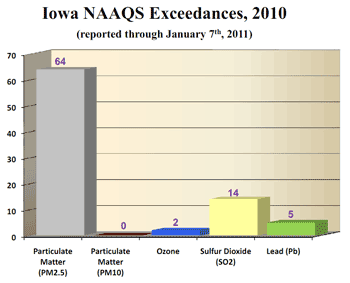
National air quality standards were exceeded a record 85 times at various monitors in Iowa during 2010, including 33 instances in Muscatine, 10 in Clinton and nine in Davenport.
According to the Iowa Department of Natural Resources (IDNR) annual report, 64 of the exceedances involved high levels of PM 2.5 (particulate matter less than 2.5 microns in diameter). A total of 14 exceedances, all occurring in Muscatine, involved high sulfur dioxide (SO2) levels, and five exceedances were for lead emissions at the Griffin Pipe monitoring site near Council Bluffs.
A National Ambient Air Quality exceedance occurs when levels of an air pollutant - PM 2.5, ozone, sulfur dioxide, nitrogen oxide, lead, carbon monoxide or particulate matter 10 microns in diameter - reach a level which is "unhealthy for sensitive groups." Those sensitive groups include young children, people with respiratory conditions such as asthma and the elderly.
In 2009, a total of 34 exceedances were recorded in the state, in 2008 only 25 exceedances were reported and in 2007 there were 48 exceedances.
Part of the reason for the higher number of exceedances is a lower standard for sulfur dioxide which went into effect in August of last year and lower permit levels for PM 2.5 and ozone in recent years.
Many of the PM 2.5 exceedances occurred in multiple locations on the same day. For instance, on Feb. 4, 2010, 16 exceedances were recorded at monitors in Keokuk, Cedar Rapids, Clinton, Waterloo, Davenport, Muscatine, Keosauqua and Iowa City.
For the full Iowa DNR exceedance report, CLICK HERE.
